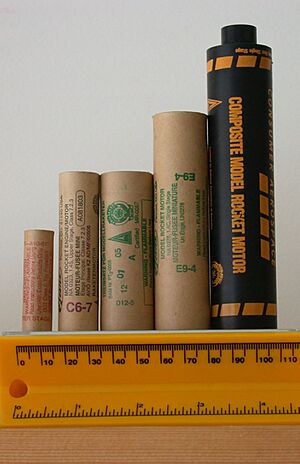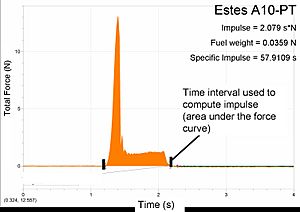Black powder rocket motor facts for kids
A black powder rocket motor helps a model rocket fly. It uses a special fuel called black powder. This fuel is made from charcoal, sulfur, and a chemical called potassium nitrate.
By changing how much of each part is used, you can change how fast the black powder burns. When it burns, it creates hot gases very quickly. These gases shoot out the back of the rocket. This powerful push makes the rocket go forward!
People in China first made simple black powder rocket motors. This was way back in the early 1200s. Over time, these motors got much better. Today, they are used for different things. Some are used in small rockets for fun. Others can carry cameras to take pictures from high up.
Black powder rocket motors are usually small. Bigger ones might explode or not work as well. They come in different sizes called classes, from 1/4 A to E. For bigger rockets, a different type of fuel is used. This is called a composite fuel. Examples include ammonium perchlorate or ammonium nitrate.
Contents
History of Black Powder Rockets
Black powder is the oldest type of rocket fuel. It was used in rockets even before it was used in guns! The three main parts of black powder are charcoal, sulfur, and saltpetre (which is potassium nitrate).
The Chinese were making black powder around the year 1045. That's about 1000 years ago! In the early 1200s, the Chinese started using black powder to power weapons. Before that, it was mostly used for fun. The first time rockets were used in war was in 1232. The Chinese used "arrows of fire" that were shot from a type of catapult.
The black powder was packed into a closed tube. This tube had a hole at one end for the hot gases to escape. The tube was attached to a long stick to help it fly straight.
Early black powder rockets were not very powerful. Rocket designs slowly got better, but mostly on paper. People had ideas and drawings for improved rockets. In 1591, a Belgian named Jean Beavie wrote about a very important idea. He drew rockets that had more than one stage. This is called multistaging. It means the rocket burns fuel in different steps. This idea was key to someday sending rockets into space!
By the 1600s, rockets were used in parts of Europe. They were sometimes used against cavalry, which are soldiers on horseback. By 1688, rockets weighing over 120 pounds were built in Germany. These big German rockets could carry 16-pound warheads.
In the late 1700s, a lawyer from London, Sir William Congreve, wanted to make rockets better. He did many careful experiments. He tried different fuels and rocket cases. He made rockets fly farther, more steadily, and more accurately. The British army used Congreve's new rockets in the Napoleonic wars.
In 1939, scientists at the California Institute of Technology were trying to make a motor to help launch airplanes. They mixed black powder with common road asphalt. This mix created the first composite motor. This new invention meant black powder was no longer used for very large rockets.
How Black Powder Rocket Fuel is Made
Black powder rocket fuel is very similar to old-fashioned gunpowder. It has one extra part called a binder. The binder is usually a substance called Dextrin.
One popular model rocket company is Estes Industries. Their rocket motors use black powder fuel. This fuel must be pressed very tightly to work well. If it's not packed tightly, it will burn too fast and might explode!
A common way to make black powder rocket fuel is:
- 75% potassium nitrate
- 10% sulfur
- 15% charcoal
Dextrin can be added as a binder (usually 0 to 5%). Sometimes, extra charcoal or metal powders (5-10%) are added. These can make a cool spark trail when the rocket flies! Adding these extras might change how fast the fuel burns.
How Black Powder Rockets Perform
Thrust is how hard the rocket pushes. Burn time is how long the fuel burns while pushing gases out. The impulse of a rocket motor is a number that tells you how much force the rocket makes and for how long.
The impulse of a black powder motor helps decide its size class. Motors are divided into classes from 1/4A to E. These classes include rockets with impulses from 0 to 40 Ns (Newton-seconds). Other types of model rocket motors can go up to an 'H' class, which is up to 320 Ns.
| Class | Total Impulse (Ns) |
|---|---|
| 1/4A | 0.001 – 0.625 |
| 1/2A | 0.626 – 1.250 |
| A | 1.251 – 2.500 |
| B | 2.501 – 5.000 |
| C | 5.001 – 10.000 |
| D | 10.001 – 20.000 |
| E | 20.001 – 40.000 |
Here are some examples of how Estes rocket motors perform:
For small black powder rocket motors (13 mm wide):
- The strongest push (maximum thrust) is between 5 and 12 Newtons.
- The total impulse is between 0.5 and 2.2 Ns.
- The burn time is between 0.25 and 1 second.
For Estes 'regular size' rocket motors (18 mm wide), there are three classes: A, B, and C.
- A class 18 mm motors: Maximum thrust is about 9.5 to 9.75 Newtons. Total impulse is about 2.1 to 2.3 Ns. Burn time is about 0.5 to 0.75 seconds.
- B class 18 mm motors: Maximum thrust is about 12.15 to 12.75 Newtons. Total impulse is about 4.2 to 4.35 Ns. Burn time is about 0.85 to 1 second.
- C class 18 mm motors: Maximum thrust is about 14 to 14.15 Newtons. Total impulse is about 8.8 to 9 Ns. Burn time is about 1.85 to 2 seconds.
There are also three classes for Estes large (24 mm wide) rocket motors: C, D, and E.
- C class 24 mm motors: Maximum thrust is about 21.6 to 21.75 Newtons. Total impulse is about 8.8 to 9 Ns. Burn time is about 0.8 to 0.85 seconds.
- D class 24 mm motors: Maximum thrust is about 29.7 to 29.8 Newtons. Total impulse is about 16.7 to 16.85 Ns. Burn time is about 1.6 to 1.7 seconds.
- E class 24 mm motors: Maximum thrust is about 19.4 to 19.5 Newtons. Total impulse is about 28.45 to 28.6 Ns. Burn time is about 3 to 3.1 seconds.
Related pages



